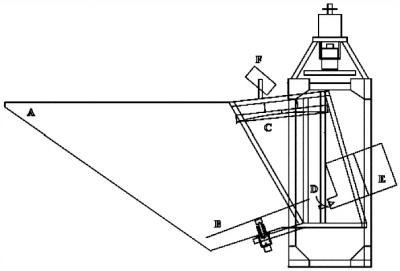Purpose of the flight and payload description
HACME was a balloon-borne experiment designed to measure subdegree-scale cosmic microwave background anisotropy over hundreds of square degrees, using a unique two-dimensional scanning strategy: a spinning flat mirror that is canted relative to its spin axis modulates the direction of beam response in a nearly elliptical path on the sky. The HACME experiment was meant to be the precursor to several spin-modulated experiments that would accurately measure the angular power spectrum using cryogenic HEMT (High Electron Mobility Transistor) amplifier receivers flown on balloon platforms to minimize atmospheric contamination and to enable large-angle chopping.
At left we can see a schematic drawing of the major optical elements of HACME. It was composed by a fixed ellipsoidal mirror (D in the drawing), a 1 meter parabolic primary mirror (C); a new 1.2 m spinning flat mirror (B), and a baffle (A) surrounding the flat mirror between 2º and 5º from the optical axes to intercept direct spillover paths of signals from the Earth to the edge of the primary mirror. The spinning flat mirror, canted 2º relative to its spin axis, modulates the telescope beam in a nearly elliptical path on the sky. The primary mirror was the original one used in the ACME instrument which was flown on balloons by the same scientific group six times between 1988 and 1994 and also performed several runs of observations from the south pole.
The HACME Q-band receiver is the same used in an earlier experiment (SP94) with a five-stage InP-GaAs HEMT multiplexed into three 2.3 GHz bandwidth subbands centered at 39.15, 41.45, and 43.75 GHz, but used as a total-power radiometer for this instrument. The output diodes for each subband connect to a low-noise preamplifier, an A/C coupling stage, and a linear voltage to frequency (V/F) converter. The output of the V/F is counted synchronously with the spin of the flat mirror.
Pointing and receiver data are stored on board the payload, and a compressed form of the data is sent to the ground. Analysis is performed on the data recovered from the hard disk after landing.
Eventually, the experience gained with HACME was transferred to its sucesor, an instrument called BEAST (Background Emission Anisotropy Scanning Telescope) flown in 2000 and COFE (Cosmic Foreground Explorer) flown in 2011.
Details of the balloon flight
Balloon launched on: 2/11/1996 at 22:55 utc
Launch site: Scientific Flight Balloon Facility, Fort Sumner, (NM), US
Balloon launched by: National Scientific Balloon Facility (NSBF)
Balloon manufacturer/size/composition: Zero Pressure Balloon N401-8/8T-11.62
Balloon serial number: R11.62-1-118
Flight identification number: 414N
End of flight (L for landing time, W for last contact, otherwise termination time): 2/12/1996 at 19:07 utc
Balloon flight duration (F: time at float only, otherwise total flight time in d:days / h:hours or m:minutes - ): 21 h
Landing site: 20 miles NE of Prescott, Arizona, US
Payload weight: 2866 lbs
During this, the first flight of the instrument, were obtained 15 hours of flight at a float altitude of 35.4 km. The HACME telescope performed as expected with no known difficulties. Operations proceeded smoothly, with detectors and all servo systems reaching expected performance for the entire flight. Of the 12 night time hours at float, 8 hours were spent mapping three extended regions near the stars a Leo, ? Eri, and ? UMi. These regions were chosen for low foreground emission and with systematic tests in mind. All regions observed were between 40º and 50º from the Galactic plane. When observed, a Leo was rising in the east, ? Eri was setting in the southwest, and ? UMi was transiting in the north. The remainder of the time was spent on calibrations, main lobe mapping using the Moon, and systematic tests such as operating without the servo systems and RF transmitters.
External references
- A Spin-Modulated Telescope to Make Two-Dimensional Cosmic Microwave Background Maps The Astrophysical Journal, 539:52-56, 2000 August 10
- Cosmic microwave background maps from the HACME experiment The Astrophysical Journal, Volume 541, Issue 2, pp. 535
- NASA Balloon Flights (1989-1998) in NASA Historical Data Book, Vol. VII: NASA Launch Systems, Space Transportation, Human Spaceflight, and Space Science, 1989-1998
- UCSB Experimental Cosmology Group University of California, Santa Barbara
633If you consider this website interesting or useful, you can help me to keep it up and running with a small donation to cover the operational costs. Just the equivalent of the price of a cup of coffee helps a lot.


